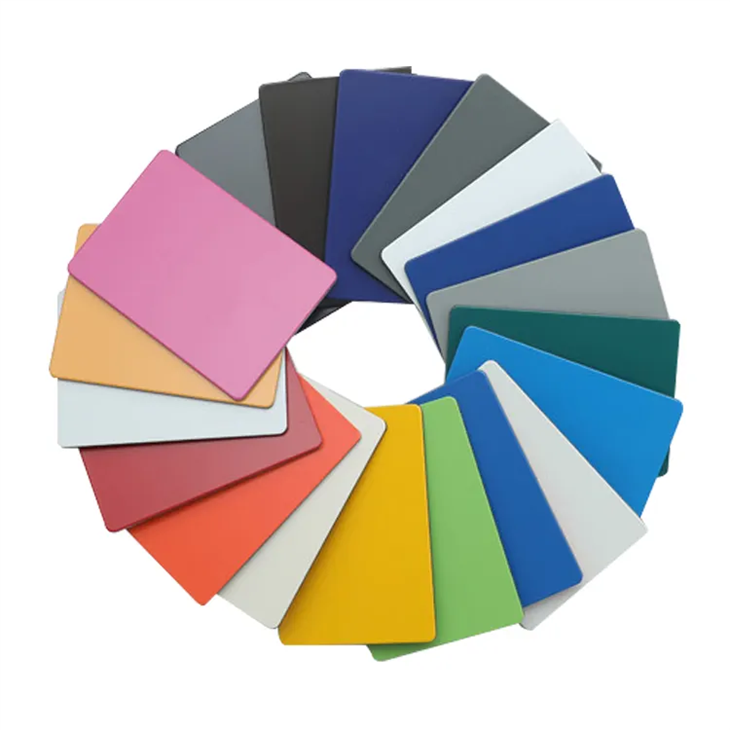Hey there! As an aluminium composite sheet supplier, I often get asked if these sheets can be used in wet environments. Well, let's dive right into it and explore this question in detail.
First off, what exactly are aluminium composite sheets? They're made up of two thin aluminium sheets bonded to a non - aluminium core. These sheets are super popular in construction and interior design because they're lightweight, durable, and offer a sleek look. But when it comes to wet environments, things get a bit more complicated.
Understanding the Basics of Aluminium Composite Sheets
Aluminium is a metal that has a natural oxide layer on its surface. This oxide layer acts as a protective barrier, preventing the aluminium from reacting with oxygen in the air and corroding. In normal, dry conditions, this oxide layer does a great job of keeping the aluminium safe. However, in wet environments, the situation changes.
Water can break down this oxide layer over time, especially if the water contains certain chemicals or salts. When the oxide layer is compromised, the aluminium is exposed to the elements, and corrosion can start to occur. But the good news is that not all aluminium composite sheets are created equal, and some are better suited for wet environments than others.
Factors Affecting the Use of Aluminium Composite Sheets in Wet Environments
1. Coating
The coating on the aluminium composite sheet plays a crucial role. High - quality PVDF (Polyvinylidene Fluoride) coatings are known for their excellent weather resistance and corrosion protection. A PVDF - coated aluminium composite sheet can withstand the harsh conditions of a wet environment much better than an uncoated one. For example, our Manufacturer Price Exterior Wall Building Materials Alucobond comes with a top - notch PVDF coating, making it a great choice for areas where it might get wet.
2. Core Material
The core material of the aluminium composite sheet also matters. Some cores are more resistant to moisture than others. For instance, a core made of a moisture - resistant polymer will be less likely to absorb water and swell, which could lead to the delamination of the sheet. Our OEM Hot Sale Construction Wall Cladding 4mm Aluminum Composite Panel uses a carefully selected core material that offers good moisture resistance.

3. Installation
Proper installation is key when using aluminium composite sheets in wet environments. If the sheets are not installed correctly, water can seep behind them, causing damage. The joints between the sheets need to be sealed properly to prevent water ingress. It's also important to ensure that there is proper drainage so that water doesn't pool on the surface of the sheets.
Examples of Wet Environments and Suitability of Aluminium Composite Sheets
1. Coastal Areas
Coastal areas are a classic example of a wet environment. The air is filled with saltwater, which is highly corrosive. Aluminium composite sheets in these areas need to be extra durable. With the right coating and proper installation, they can be used for exterior wall cladding of buildings. Our PVDF - coated sheets can resist the saltwater spray and the high humidity, making them a reliable choice for coastal construction projects.

2. Indoor Bathrooms and Kitchens
Indoor wet areas like bathrooms and kitchens also pose a challenge. While the humidity levels are not as extreme as in coastal areas, there is still a constant presence of water. Aluminium composite sheets can be used for wall cladding in these areas, especially if they are coated and installed correctly. Our New Product Bamboo Charcoal Wall Panel For Indoor Decoration not only looks great but also offers good moisture resistance, making it suitable for these indoor wet environments.
3. Swimming Pools and Water Parks
In swimming pools and water parks, the sheets are constantly exposed to water. Special care needs to be taken in these environments. The sheets should have a very high - quality coating and be installed with proper waterproofing measures. With the right precautions, aluminium composite sheets can be used for decorative elements and even some structural components in these areas.
Advantages of Using Aluminium Composite Sheets in Wet Environments
Despite the challenges, there are some great advantages to using aluminium composite sheets in wet environments.
- Lightweight: They are much lighter than traditional building materials like stone or concrete. This makes them easier to install, especially in areas where weight is a concern.
- Aesthetic Appeal: They come in a wide range of colors and finishes, allowing for creative and attractive designs in wet areas.
- Durability: When properly selected and installed, they can last for a long time, even in wet conditions.
Precautions and Maintenance
If you decide to use aluminium composite sheets in wet environments, here are some precautions and maintenance tips:
- Regular Inspections: Check the sheets regularly for any signs of damage, such as peeling coating or delamination.
- Cleaning: Clean the sheets periodically with a mild detergent and water to remove any dirt or debris that could trap moisture.
- Repair: If you notice any damage, repair it immediately to prevent further deterioration.
Conclusion
So, can aluminium composite sheets be used in wet environments? The answer is yes, but with some conditions. By choosing the right sheets with high - quality coatings and suitable core materials, and by ensuring proper installation and maintenance, you can use these sheets in a variety of wet environments, both indoors and outdoors.
If you're interested in purchasing aluminium composite sheets for your project, whether it's for a wet environment or not, I'd love to talk to you. We offer a wide range of products to meet your needs. Just reach out to us for more information and let's start a great business relationship!
References
- "Aluminium in Construction" - A comprehensive guide on the use of aluminium in the construction industry.
- "Corrosion Resistance of Aluminium Alloys" - Research on the factors affecting the corrosion of aluminium in different environments.